How to Fix COD Cold War “UI Error”
Some Call of Duty: Cold War players are encountering UI Errors (27711, 6655, 100002, 70754, 0014, 27711, etc.) whenever they find themselves inside the Cold War’s Zombie menu tweaking their gear or getting ready to start a new run. This issue is reported to occur on both consoles (old-gen and next-gen) and PC.

After we investigated this particular issue, it turns out that there are several different underlying causes that might trigger this error code with Call of Duty: Cold War. Here’s a list of potential causes that might be causing this problem:
- Outdated COD Cold War version – According to some affected, users, this particular issue is oftentimes caused by a new game update that was pushed while you were spending time inside the menus. In this case, you should be able to fix the issue by closing the game before opening it up again in order to force it to update.
- Game file corruption – As it turns out, this type of issue can also be caused by some type of game file corruption that is preventing the game from loading certain UI elements in Zombie mode. In this case, you should be able to fix the problem by repairing the game (on Battle.Net) or by reinstalling it (on consoles).
- Outdated GPU drivers – In case you’re seeing this error code while launching the game on a PC that’s more than equipped to render the game, you should start to consider a driver issue. An outdated or partially incompatible driver might prevent your PC from running the game. In this case, you need to update the GPU drivers using the proprietary updating technology (Nvidia Experience or Adrenalin)
Now that you are familiar with every potential culprit that might be responsible for this issue, here’s a list of verified methods that other affected users have successfully used to get to the bottom of this issue:
1. Update to the latest version of COD Cold War
As it turns out, you can expect to see this error code in those instances where the game developers have just pushed a new update for the Zombie mode. In this case, the error is thrown because there’s a version mismatch that needs to be sorted out.
If you find yourself in this scenario, the only way to resolve this issue is to force the game to update – In most cases, it’s enough to close the game and open it up again (once you re-open it, you will be prompted to update to the latest version available).
Note: If Battle.net prompts you that there’s a pending update waiting to be installed, don’t launch the game until the updating operation is complete.
Also, if you’re prompted to restart by the game launcher, do so before seeing if the issue was fixed.
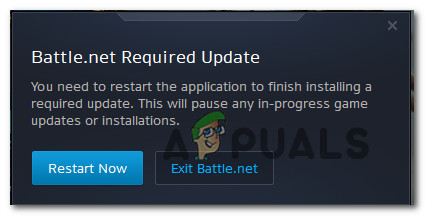
Note: On consoles, it’s enough to close the game once and you’ll be prompted to install the update the next time you attempt to open the game.
If you already ensured that you are running the latest version of the game, move down to the next potential fix below.
2. Repair/Re-install the COD Cold War
According to several affected users, this issue can also be rooted in some kind of system file corruption that is preventing the game from loading certain UI elements of the Zombie mode. In this case, you should be able to resolve the ‘UI error’ altogether by repairing the game (on PC) or reinstalling the game (on consoles).
Depending on the platform where you’re encountering this particular issue, follow the applicable sub-guide below to treat a corruption-issue problem by repairing or reinstalling Call of Duty: Cold War:
2.1 Repairing the COD Cold War on PC ( Battle.Net)
- Ensure that Call of Duty Cold War is completely closed and no background process that might affect the repair operation is currently running.
- Next, open up the Battle.Net application and click on the Games tab from the menu at the top.
- With the Games tab selected, click on the Call of Duty Cold War to select it.
- After you do this, move over to the right-hand section of the screen and click on Options > Scan & Repair.

Repairing the game - At the confirmation prompt, click on Begin Scan and wait for the operation to complete.
- Wait until the operation is complete, then restart your computer and launch Call of Duty Cold War once again to see if the same error code is still occurring when you try accessing the Zombie mode.
2.2 Reinstalling the COD Cold War on PS4
- From the main menu of your PS4 console, go ahead and access the Library menu.

Accessing the Library menu on Ps4 - Inside the Library menu of your PS4 console, select Games (from the left-hand section of the screen), then move over to the right-hand section of the screen and locate the entry associated with Overwatch and press the Options button on your computer.
- Next, from the context menu that just appeared, use the Delete option and confirm the operation when asked to.
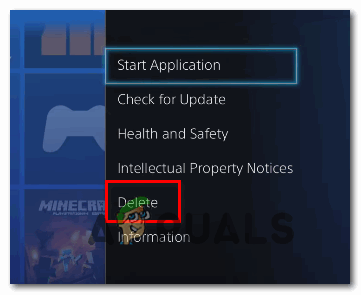
Deleting the current COD installation on your PS4 - Once the uninstallation procedure is finally complete, reboot your console, then reinstall Overwatch once again once the next startup is complete.
- After the game gets reinstalled and every relevant update is applied to it, launch it to see if the UI error is now resolved.
2.3 Reinstalling the COD Cold War on PS5
- Make your way to the main dashboard of your PS5, then select Call of Duty Cold War and press Options (on your DualSense Controller) to bring up the context menu.
- From the context menu that just appeared, select Delete and confirm at the final confirmation prompt.
- Next, select every sub-component of Call of Duty Cold war before clicking ok and starting the uninstallation.
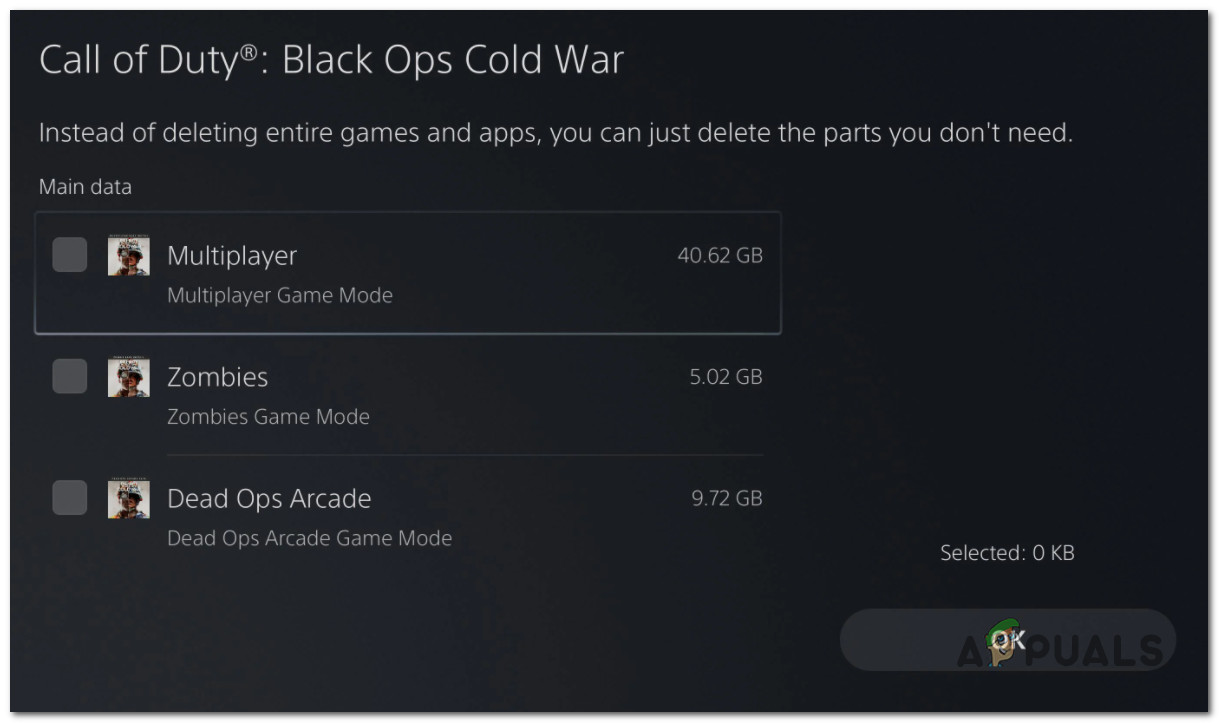
Uninstalling Call of Duty - After the operation is complete, use the main dashboard once again to navigate all the way to the right end of your list of items and access the Game Library menu.
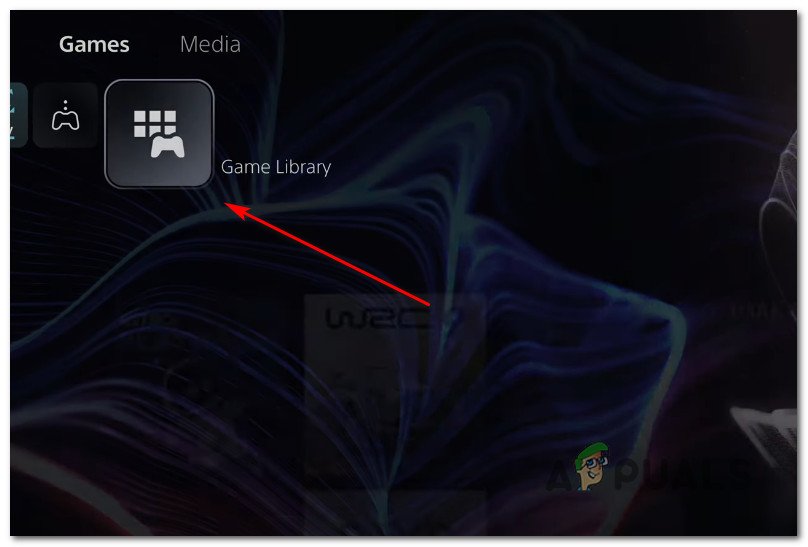
Accessing the game library menu on ps5 - Once the list of Library games is fully loaded again, navigate to the game you’ve just reinstalled, select it by pressing X, then hit the Download button and wait for the operation to complete.
- Once COD: Cold War is re-downloaded and installed, restart your system before opening it for the first time and see if the error is now fixed.
2.4 Reinstalling the COD Cold War on Xbox One / Xbox Series X
- From the main dashboard of your Xbox One console. Start by clicking on the Xbox button on your controller, then use the guide menu that just appeared to access the My games & Apps menu.
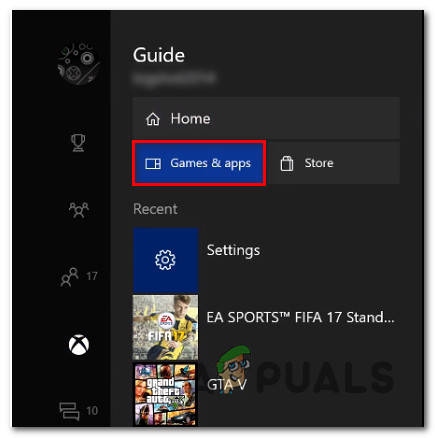
Accessing the MY Games and apps menu - Once you’re inside the Game & Apps menu, scroll down through the list of installed applications and locate Call of Duty: Cold War.
- After you discover the listing associated with Overwatch, press the Start button and choose Manage game from the newly appeared context menu.
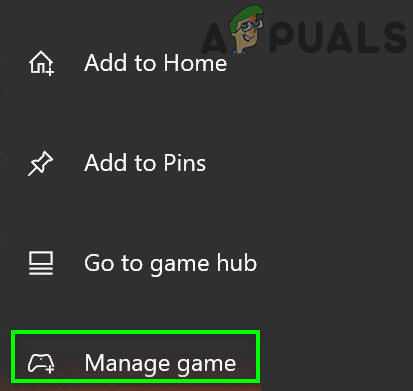
Managing the COD: Cold War game - Once you reach the next menu, select Uninstall all, then follow the on-screen instructions to ensure that you are uninstalling both the base COD: Cold War game + every add-on that you might have been installed on top of the base installation.
Note: Don’t worry about this operation affecting your character data, load-outs, etc. This data is safely backed up on the cloud and will not be touched by the reinstallation procedure. - After the uninstallation is complete, reboot your console the go-ahead and reinstall Call of Duty Cold War from scratch using its store listing.
- Launch the game once again and see if the problem is now fixed.
3. Update GPU drivers (PC Only)
If you encountering this ‘UI error’ every time you attempt to launch the game (you don’t even get to the Zombie sub-menu), chances are you’re dealing with a driver issue.
In most cases, this is due to an outdated driver graphics card version or due to a partially incompatible GPU driver. In this case, you should be able to fix the issue by reinstalling every GPU driver that you’re actively using.
Note: The steps of updating your GPU drivers will be different depending on your GPU manufacturer. We created two separate guides that will help you uninstall and reinstall your GPU – whether you’re using AMD or Nvidia graphics cards.
3.1 Reinstalling the GPU drivers on AMD
- On your default browser, visit the download page for the AMD Cleanup utility and download the latest version.
- Once the AMD Cleanup utility is downloaded, double-click on its executable, then click Yes at the confirmation prompt to run the utility in safe mode and uninstall every AMD driver.
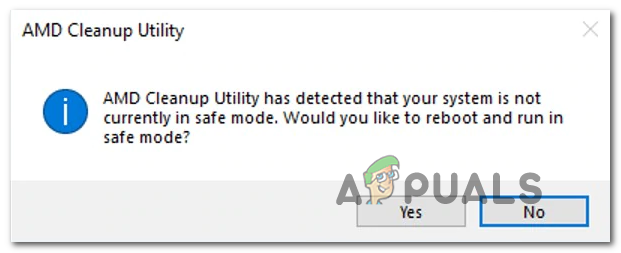
Running the AMD cleanup utility Note: This utility is designed to thoroughly remove every installed AMD drivers, registry entries, and driver store signatures – Saving you from searching and uninstalling every driver file manually. To ensure that you’re not leaving behind any leftover files, ensure that you run the utility in safe mode.
- To start the utility, click Ok at the second prompt to start the AMD cleanup process. After you do so, the utility will run in the background.
Note: During this operation, your display might flicker or turn black for a couple of seconds. This is absolutely normal as the display components are being removed. - Once you see the success message, click on Finish, then restart your computer manually if you’re not prompted to do so automatically.
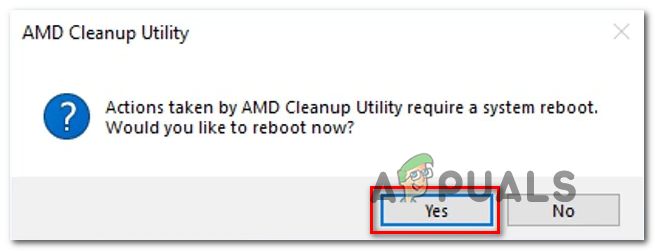
Rebooting after AMD driver removal - After the next boot sequence is complete, visit the download page of the Auto-Detect GPU page, then scroll down to the Auto-Detect and Install Radeon Graphics Drivers for Windows and click on Download Now.
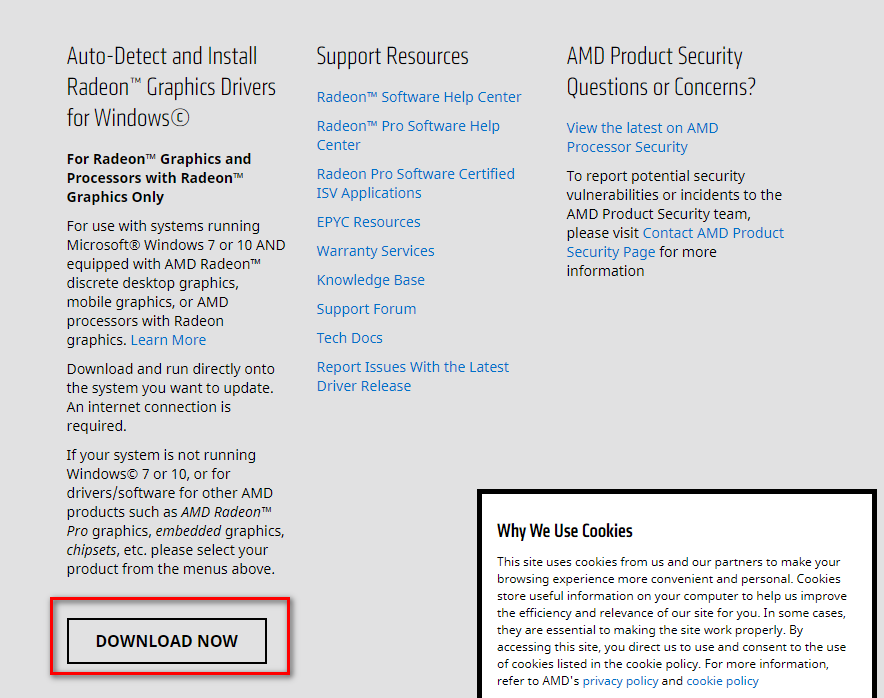
Downloading Adrenalin - Once the executable is downloaded, open it by double-clicking and follow the on-screen instructions to install Radeon Adrenalin.
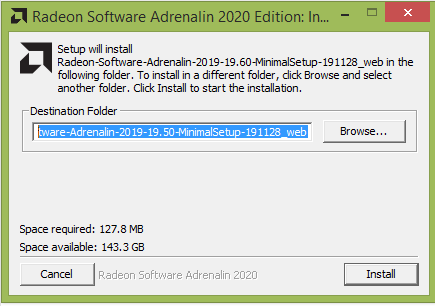
Unpacking the Adrenalin dependencies - Note: You can change the default destination folder again if you want, but this is not recommended.
- Once the download is complete, the utility should automatically launch itself in an attempt to detect the installed AMD graphics product and operating system.

Running the Adrenalin software - After the tool successfully detects your system configuration and the drivers that you need, install both the Recommended and Optional driver packages by selecting both and clicking on Install.

Installing the Recommended Adrenalin drivers - Next, accept the EULA after reviewing the terms and conditions, then click on Install to start the installation.
- After every needed driver is installed, restart your computer and attempt to launch the game once the next startup is complete to see if the issue is now resolved.
3.2 Reinstalling the GPU drivers on Nvidia
- Press Windows key + R to open up a Run dialog box. Next, type ‘appwiz.cpl’ inside the text box and hit Enter to open up Programs and Files menu.

Opening the Programs and Features screen - Inside the Programs and Features menu, proceed by clicking on the Publisher tab to order the list of installed programs by their publisher.
- Find the entries published by NVIDIA Corporation and systematically right-click on them and click on Uninstall every item using the context menu.

Uninstalling every Nvidia driver - Next, follow the on-screen prompts to complete the uninstallation process. Do this systematically with every driver that shows up as published by Nvidia Corporation.
- After every Nvidia driver is uninstalled, reboot your computer and wait for the next startup to complete.
- Once the next startup is complete, visit the Nvidia GeForce Download page and install GeForce Experience by clicking on the Download Now button and following the on-screen instructions.

downloading Nvidia experience Note: This utility works by automatically finding and recommend the drivers that you need to install according to your GPU model.
- Open Nvidia Experience, sign in with an account, and then install the recommended drivers from the Drivers page.
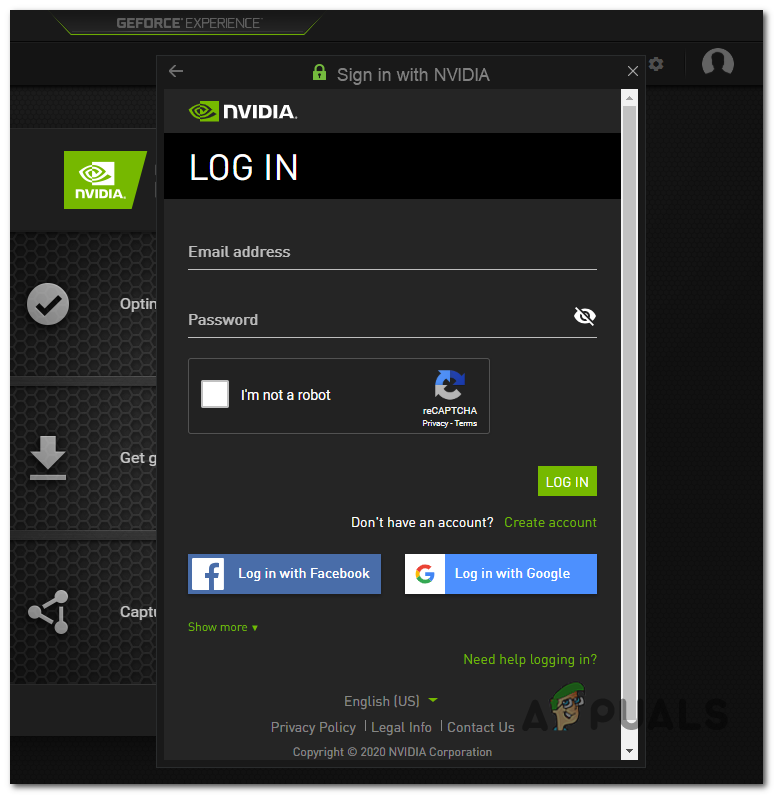
Sign in with Nvidia Experience - After every recommended driver is installed, reboot your computer once again and see if the issue is resolved at the next computer startup.
- Launch the game that was previously triggering the UI error and see if the problem is now fixed.





